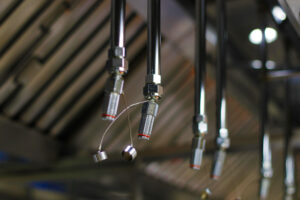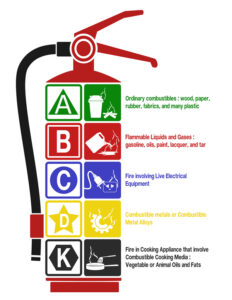A Guide to Understanding the Differences Between Various Types of Fire Suppression Systems
As the common phrase goes: We plan for the worst and hope for the best. Deciding on how to respond to a potential fire threat is critical for businesses of all types. We hope that the need for a response to a fire will never arise, but it’s crucial to plan appropriately.
Many of us are familiar with the extended, historical use of water and sprinklers to protect against fires. But the world of fire suppression systems has evolved dramatically over the past century. Resources are now available to us that were not even thought of a half-century ago. Scientific developments have provided considerably more dynamic and suitable means of responding to the ancient threat that fire poses.
In this article, we cover the differences between fire protection and fire suppression. And we explore the different primary types of fire suppression systems available.
What are the different types of fire suppression systems?
 In many cases, a distinction exists between fire suppression systems and fire protection systems. The two terms—suppression and protection—overlap in many regards. Some fire safety providers, however, may not distinguish between the terms at all. For the sake of our exploration, fire suppression systems differ from fire protection systems by their use of an alternative to the water used in more traditional fire sprinkler systems.
In many cases, a distinction exists between fire suppression systems and fire protection systems. The two terms—suppression and protection—overlap in many regards. Some fire safety providers, however, may not distinguish between the terms at all. For the sake of our exploration, fire suppression systems differ from fire protection systems by their use of an alternative to the water used in more traditional fire sprinkler systems.
For instance, fire sprinkler systems would be identified under the category of protection. These systems are used across the globe in commercial and residential locations. They rely on various types of water distribution to contain and eliminate the threat and spread of fires.
In contrast, a fire suppression system uses varying alternatives to water. These substitutes for water may include resources such as gas, chemicals, or foam. Suppression systems seek to assert action before a fire gains the chance to spread. And they can often provide benefits that can’t be found with more traditional sprinkler systems.
The primary types of fire suppression systems:
- Inert gases
- Carbon Dioxide (CO2)
- Clean Agent
- Water mist
Exploring the various types of fire suppression systems
At its most basic, a fire suppression system is a means of identifying, controlling, and extinguishing a fire. These systems of suppression rely on agents other than water to respond to the threat of fire. Using these alternatives has proven to offer various benefits, such as protecting against damage to sensitive equipment and more effective fire prevention. Suppression systems aim to act before a fire can develop or spread through a building or space—often activating more quickly than traditional fire sprinklers.
Inert gas suppression systems
Inert gas suppression systems’ primary function is to remove enough oxygen in a space to eliminate the potential combustion of a fire. Most gas systems are preferred for uses in buildings where humans might be present. Unlike using CO2, inert gases remove enough oxygen to prevent fires but not so much to pose possible suffocation to occupants.
Beyond their general safety for humans, inert gases also offer the benefit of being safe for sensitive equipment such as computers, televisions, and phones. They are also classified as “clean agents” because they do not cause damage to the ozone layer or contribute to global warming. Examples of inert gases might include inergen, argonite, or nitrogen.
Carbon Dioxide (CO2) suppression systems
Suppression systems that utilize CO2 also rely on their ability to remove oxygen rather than extinguish heat. Unlike inert gases, however, CO2 extracts too much oxygen for occupants to avoid suffocation. As a result, this type of suppression system is not used for buildings or spaces where humans are present. Instead, they are commonly used for very confined applications or areas not accessible to personnel.
Generally, using CO2 suppression systems is also not recommended for use in areas with electrical equipment. Carbon dioxide is stored at frigid temperatures and can pose the risk of thermal shock to hardware or electronic components.
Clean agent suppression systems
There are numerous reasons for how these suppression systems came to be understood as using “clean agents.” For one, they are safe for humans. But they also do not pose a significant risk to the environment. They also have a meager impact on the atmosphere or global warming. Finally, clean agents evaporate and do not leave a residue after being discharged to suppress a fire.
Clean agents can be stored as a liquid or gas. Discharging a clean agent releases the storage chemical(s) as gas to suppress a fire. The gaseous discharge can serve the purpose of disrupting up to three different elements that can sustain a fire: a fuel source, oxygen, or heat. The clean agent also commonly acts very quickly—distributing highly concentrated levels in around 10 seconds. This quick and effective execution makes clean agents efficient at suppressing fire before it can cause significant damage.
Due to their safe and productive application, clean agents are primarily preferred for protecting both occupants and sensitive materials. They are often used to protect the fragile resources found in museums, archives, or libraries. And clean agents are commonly preferred for ensuring the safety of computer or server rooms.
Water mist suppression systems

This type of suppression system is the only exception to the rule mentioned earlier that distinguishes fire suppression systems from protection systems by the use of water. However, water mist suppression involves a distinctly different tactic than sprinkler systems. These misting systems use remarkably less water than fire sprinklers and do not cause collateral damage to equipment. Rather than cooling a fire’s heat, water mist suppression systems evaporate and produce starvation of oxygen.
Water mist suppression systems present the advantages of immediate activation, environmental and human safety, and minimal to no water damage. Because the fine mist evaporates quickly, these systems are primarily considered safe for sensitive equipment and supplies.
Before you go
At WFX Fire, Lock, & Security, we are committed to ensuring you have the most reliable and trustworthy resources for fire suppression systems. Our team can ensure that your installation is conducted with the utmost professionalism—while also providing maintenance to ensure your systems keep you safe in the long run.
You can schedule a consultation or call us today at 855-WFX-1978




 Can I Use a Class K Fire Extinguisher to Fight a class A Fire?
Can I Use a Class K Fire Extinguisher to Fight a class A Fire?